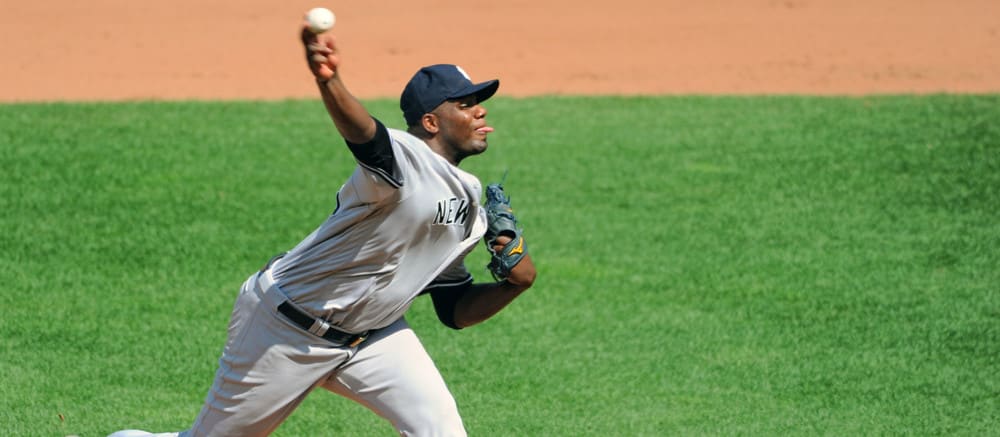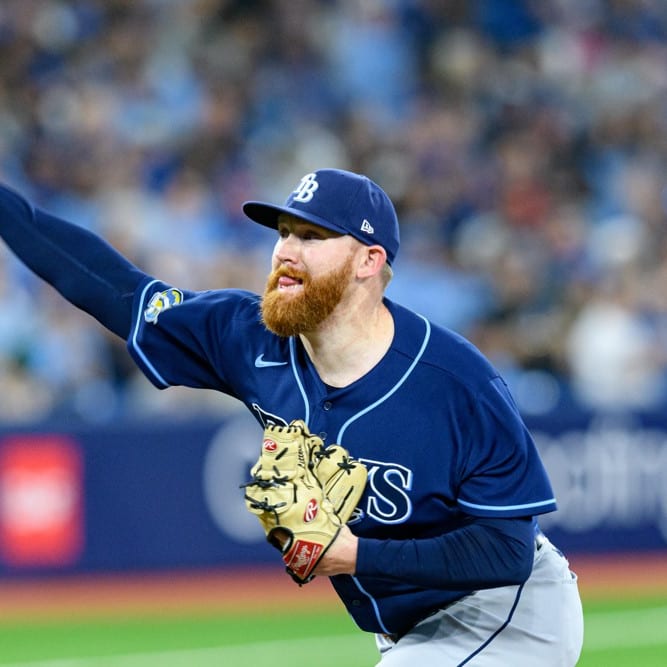This article is part of our The Saber's Edge series.
Pineda isn't the only pitcher who struggled to keep his ERA near is ERA estimators. NFBC owners are picking Robbie Ray right after Pineda. Ray (11th highest K-BB%) posted a 4.90 ERA last year while his ERA estimators were all less than 3.80. Historically, some pitchers have a higher ERA than FIP.
This week, I will determine which traits indicate which pitchers will struggle with an ERA greater than their ERA estimators.
One issue that must be immediately addressed is a survivor bias. If a pitcher has a 4.00 FIP talent level but a 4.50 ERA talent level, he will work himself out of the league quickly. On the other hand, if a pitcher has the same 4.00 FIP talent level but a 3.50 ERA talent level, he will hang around longer. Or at least until he tears up his shoulder. Teams aren't
Pineda isn't the only pitcher who struggled to keep his ERA near is ERA estimators. NFBC owners are picking Robbie Ray right after Pineda. Ray (11th highest K-BB%) posted a 4.90 ERA last year while his ERA estimators were all less than 3.80. Historically, some pitchers have a higher ERA than FIP.
This week, I will determine which traits indicate which pitchers will struggle with an ERA greater than their ERA estimators.
One issue that must be immediately addressed is a survivor bias. If a pitcher has a 4.00 FIP talent level but a 4.50 ERA talent level, he will work himself out of the league quickly. On the other hand, if a pitcher has the same 4.00 FIP talent level but a 3.50 ERA talent level, he will hang around longer. Or at least until he tears up his shoulder. Teams aren't going to allow ERA inflating pitchers to keep throwing unless their ERA estimators are significantly below average.
Several factors can possibly contribute to an inflated ERA. Allowing too much hard contact and therefore more hits is the most obvious. Second, a major handedness platoon split leads to one batter handedness owning the pitcher and the pitcher owning the opposite handed hitters. Also, some pitchers throw better out of the windup but below league average once runners are on base. Finally, the defense behind the pitcher must be taken into account. Today will focus on pitchers' batted ball profiles.
I will use data from FanGraphs since it includes batted ball data. This data limits me to pitcher seasons after 2001. With the limits in mind, I started with pitchers who had at least 500 innings as a starter. From this list, only one pitcher posted a 1.00 split between his ERA and FIP. Again, one reason for this could be that pitchers with a higher split get weeded out.
Of the 287 pitcher sample, the difference quickly drops with only 14 pitchers (5 percent) having a half run split and only 32 (11 percent) having a split of a third of a run. The key to remember is that few pitchers maintain a large split as most regress back to the norm. But I am going to help find that 5 percent . Here is the statistical breakdown of the above pitchers grouped by those with an FIP-ERA of a great than .50, between .33 and .50 and the rest.
| MEDIAN VALUES | K/9 | BB/9 | HR/9 | K% | BB% | K-BB% | WHIP | BABIP | LOB% | ERA | FIP | xFIP | SIERA | IP | GB% |
| ERA-FIP >= .5 | 6.43 | 2.96 | 1.13 | 16.2 | 7.5 | 8.2 | 1.46 | .311 | 67.8 | 5.22 | 4.40 | 4.30 | 4.38 | 649 | 44.6 |
| ERA-FIP .33 to .5 | 6.51 | 2.89 | 1.02 | 16.9 | 7.5 | 9.0 | 1.37 | .307 | 69.7 | 4.57 | 4.15 | 4.11 | 4.23 | 937 | 43.6 |
| Rest | 6.79 | 2.85 | 1.05 | 17.6 | 7.5 | 10.0 | 1.33 | .292 | 72.1 | 4.14 | 4.22 | 4.20 | 4.25 | 1,026 | 44.2 |
| STANDARD DEVIATION | K/9 | BB/9 | HR/9 | K% | BB% | K-BB% | WHIP | BABIP | LOB% | ERA | FIP | xFIP | SIERA | IP | GB% |
| ERA-FIP = .5 | 1.30 | 0.66 | 0.15 | 3.8 | 1.5 | 4.5 | 0.13 | .007 | 2.6 | 0.53 | 0.50 | 0.50 | 0.50 | 337 | 3.5 |
| ERA-FIP .33 to .5 | 1.47 | 0.80 | 0.17 | 4.3 | 1.9 | 5.2 | 0.12 | .006 | 2.3 | 0.53 | 0.53 | 0.49 | 0.54 | 273 | 6.5 |
| Rest | 1.44 | 0.74 | 0.22 | 4.0 | 1.8 | 4.2 | 0.11 | .012 | 2.3 | 0.53 | 0.54 | 0.48 | 0.49 | 549 | 6.0 |
Note: I will stick with FIP-ERA as the values for xFIP and SIERA are close to the FIP value. The reason they are similar is their heavy reliance on strikeout and walk rates.
The first key to notice is the higher BABIP for the high ERA groups. It's about 20 points higher for the high ERA group than most of the pitchers.
The next and biggest factor is the standard deviation in groundball rate. For the top group, it is an insanely low 3.5 percent. Pitchers with a 40 to 50 percent GB% historically post an ERA greater than their FIP around 0.1 ERA. The reason for this difference is pitchers with less than 40 percent GB% allow enough BABIP suppressing flyballs to overcome the extra home runs. Pitchers with more than 50 percent GB% allow more groundballs, which force hitters to go base-to-base. Also, they induce rally-killing double plays. When a pitcher lives in the middle range, he has the worst of both worlds, including a high number of hit producing line drives.
The final factor, which I didn't expect, are the lower than normal walk and strikeout rates. I figured these pitchers would have better numbers to stay in the league, but it seems some teams kept them around. This finding is not that big of a deal, but when combined with the previous information, the higher ERA values make more sense. These pitchers allow more contact because of the low strikeout rate. More base runners are on base with the walks. Since they already allow more line drives, more runs are likely to score.
Looking at the factors another way is to compare pitchers with a high ERA-FIP in a season to the next season. From 2002 to 2016, 170 starters (min. 100 IP) had an ERA-FIP of .50. I grouped the pitchers into a 40-50 percent GB% group and then the rest. Of the 40-50 percent group, 31 percent saw their ERA-FIP stay above .50 with the median value being +0.23. Of the other group (high and low GB% pitchers), 24 percent saw an ERA-FIP of .50 or more with the median value being +0.11.
Using another comparison, the pitchers who saw their ERA-FIP stay above 0.50, posted a median K-BB% of 9.9 percent while the ones who improved had a median value of 11.0 percent. Finally, by using a 40-50 percent GB% and less than 10 percent K-BB%, the median ERA-FIP in season two is 0.25. This value isn't that different than the .23 value for just the 40-50 percent group. These pitchers are the ones to avoid until they show some signs of controling the hard-hit contact they allow.
In 2016, 20 starters (min. 100 IP) had an ERA-FIP of .50. Here they are ranked by GB%.
| PLAYER | IP | K-BB% | GB% | ERA-FIP |
| Marcus Stroman | 204 | 13.1 | 60.1 | 0.66 |
| Dallas Keuchel | 168 | 13.7 | 56.7 | 0.68 |
| Aaron Nola | 111 | 19.0 | 55.2 | 1.70 |
| Sonny Gray | 117 | 10.1 | 53.9 | 1.02 |
| Mike Leake | 176 | 12.5 | 53.7 | 0.86 |
| Edinson Volquez | 189 | 7.4 | 51.2 | 0.80 |
| Chad Bettis | 186 | 9.7 | 51.2 | 0.53 |
| James Paxton | 121 | 18.2 | 48.1 | 0.99 |
| Tyler Duffey | 133 | 13.8 | 47.9 | 1.70 |
| Gio Gonzalez | 177 | 14.6 | 47.6 | 0.81 |
| Wade Miley | 166 | 12.4 | 47.3 | 0.92 |
| Michael Pineda | 175 | 20.4 | 45.8 | 1.02 |
| Robbie Ray | 174 | 18.9 | 45.7 | 1.14 |
| Gerrit Cole | 116 | 12.3 | 45.6 | 0.55 |
| Archie Bradley | 141 | 11.9 | 45.1 | 0.92 |
| Christian Friedrich | 129 | 8.5 | 44.9 | 0.64 |
| Adam Wainwright | 198 | 12.0 | 43.8 | 0.69 |
| Jon Gray | 168 | 17.7 | 43.5 | 1.00 |
| Shelby Miller | 101 | 6.1 | 41.9 | 1.28 |
| Stephen Strasburg | 147 | 23.2 | 39.5 | 0.67 |
Two pitchers, Miller and Friedrich, meet the both the groundball and strikeout-walk requirements. They might be candidates to expect their high ERAs to remain. Additionally, pitchers in the middle group likely will see their ERA a quarter run higher than their FIP this season.
I have made some progress but more work has to be done on predicting high ERA pitchers. Next week, I will continue by concentrating on team defense and handedness splits. Until then, let me know if you have any questions.










